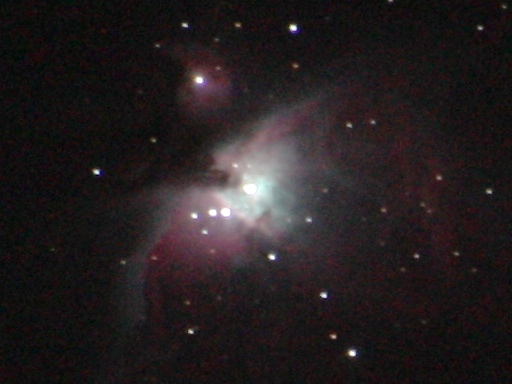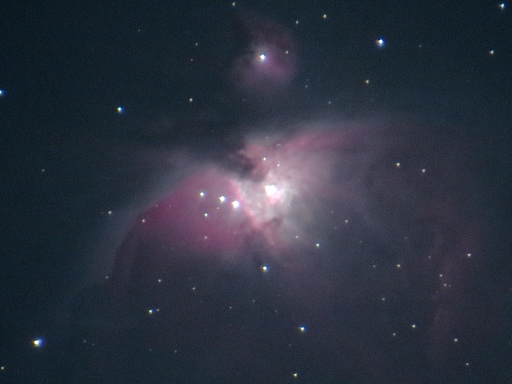Orion Nebula - Canon 450D vs. SX50 HS
Posted by Wesley onI wanted to revisit my thought that the DSLR (Canon EOS 450D) would take better deep-sky photos than a P&S (Canon PowerShot SX50 HS). The latter has a much more powerful zoom lens, so maybe it could help overcome the limitations of the small sensor. 450D's APS-C sensor has 13.3 times the area of the 1/2.3" sensor used in the SX50 HS.
After some trial & error, I found that my iOptron SkyTracker, once properly calibrated, could be usable even at a focal length of 1200mm (35mm equivalent) if the exposure time is 30 seconds or less. So I decided to take photos of the beautiful Orion Nebula at the maximum zoom of both cameras.
The 450D was able to take a low-noise photo of the nebula with nice-looking colours. But the limit of the zoom was apparent. Also, under the below-freezing temperatures (it was around -2C) the infinity focus of the lens shifted further out after about an hour.
With the SX50 HS, the resulting photos were expectedly more grainy in general at full resolution. I felt that the ISO 100 setting on SX50 HS would still yield a grainier photo than 450D's ISO 400 setting. But the super-zoom lens and stacking were able to make up for this. After taking the photos at the maximum zoom and reducing the size, the photos still had more details than that of the 450D.
Judge for yourself with the two photos above. I should note that even when stacked, 450D couldn't get much more details out.
I guess the SX50 HS is still quite alright after all. Oh, and the focus was more or less stable during the similar long session under below-freezing temperatures. I think 450D needs a better zoom lens... or a real telescope to make it fulfill its potential.
[#1]
Device: Canon EOS 450D + Tamron 18-270mm Di II VC PZD
Settings: 432mm - ISO 200 - 120s - f/6.3
Filters: None
Time: 2015-02-01 21:46 KST
Location: Naju, Korea
[#2]
Device: Canon SX50 HS
Settings: 1200mm - ISO 400 - 30s - f/6.5
Filters: None
Time: 2015-01-31 23:12 KST (23:12-23:49)
Location: Naju, Korea
10 photos stacked with RegiStax 6.1.0.8
Defined tags for this entry: astronomy, Canon EOS 450D, Canon SX50 HS, iOptron SkyTracker, nebula, Orion, star

